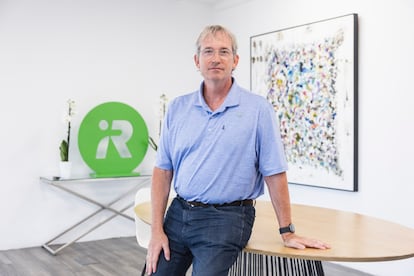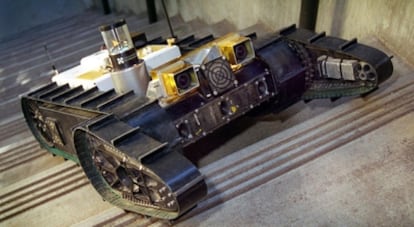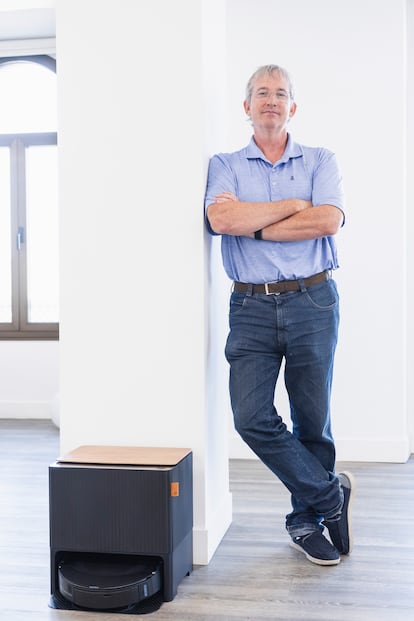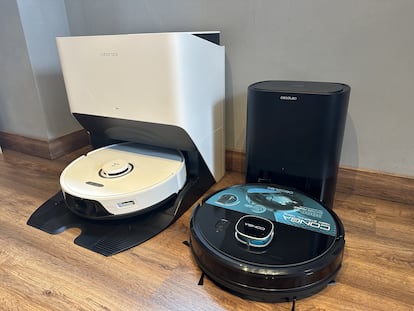Colin Angle, iRobot chief: ‘The original Roomba algorithm is the same as the one our anti-landmine robots used’
The founder and CEO of iRobot, the company that manufactures the well-known automatic vacuum cleaners, ensures that the users’ personal data is safeguarded with the company’s devices

“I’ve only had one job in my entire life: this. We had been promised robots in books and movies, but I didn’t see any. I founded iRobot after graduating from MIT with the goal of advancing the robotics industry.” He has succeeded, at least to some extent. Colin Angle has been manufacturing robots of all kinds for more than 30 years. His first steps were taken with the Department of Defense, to whom he has sold thousands of robots on caterpillar tracks that deactivate anti-personnel mines. It was his reconnaissance robots that searched the ruins of the Twin Towers for survivors after the 9/11 attacks.
But his greatest success came from the popularity of Roomba robot vacuum cleaners. Already a kind of pop icon, they led the way in the domestic robotics market, which according to the engineer will be “huge” in a few years. “The original Roomba algorithm is the same one used by the robots we made for the Pentagon, but with a built-in vacuum cleaner,” says Angle.
iRobot’s gadgets come equipped with powerful software and various sensors that allow them to move with reasonable precision. They vacuum and mop efficiently without the need for human intervention. They are able to recognize if we are at home or not (by searching for our devices via Bluetooth), so as to start cleaning when they will not disturb us. The technology has not gone unnoticed among the giants of the sector. In August of last year, Amazon announced its intention to acquire the company. The transaction is still to be approved by the U.S. regulator, which must study whether it violates antitrust laws. This summer, the European Commission opened its own investigation in this regard. “We believe that Amazon is focused on a very long-term vision and that this can give iRobot the opportunity to innovate faster than until now,” he says. Angle is visiting the offices of EL PAÍS in Madrid during his European tour to present the latest Roomba models.
Question. What is new about the latest models compared to the previous ones?
Answer. We now have the best robot vacuum on the market, the J9+, and the best robot vacuum and mop, the Combo J9+. We have improved it so that the robot is able to clean for 60 days without having to touch it. The same goes for the robot mop: while before the water had to be refilled after every mission, now this is done automatically at the emptying, refilling, and loading dock. The vacuum is now more powerful, and we have a system we call Dirt Detective that allows the robot to clean each room the way you want.

Q. What does it mean?
A. We have incorporated software that draws a map of the house and the different rooms, and on it you can see what is in each room, how dirty it has been historically and other considerations that help you understand what happens in every corner of your home. For example, the dining room should be cleaned more than the hallway and always after meals, or that it is better to clean the bathroom after the kitchen, and not the other way around. It comes up with specific cleaning plans based on the type of floor and accumulated dirt and predicts priority areas.
Q. How do you imagine robotic cleaning in ten years?
A. The intelligence that makes this robot great can be applied to more things. Why can’t we make other devices in the home understand where they are and what we need? For example, air purifiers are often set to low power because they make a lot of noise, and then they are ineffective. Why can’t the appliance know when is a good time to actually work [without disturbing anyone]?
Q. Is your idea is to integrate Roomba robots with more home appliances?
A. The concept of smart home is very confusing today. There are some good ideas, but the smart home is not very smart. I think the home needs to be thought of more as a robot, as a system. And 10 years from now, iRobot will want to do more than just vacuum and mop floors.

Q. Amazon has smart home devices like its Echo voice assistant, Ring doorbells and cameras, and the Astro robot. Would they fit into that plan?
A. Amazon has a great catalog, and we have a good product and good technology. The company is very interested in making products that delight customers. They design products for many parts of the home. So, our visions are aligned, yes.
Q. Will we end up talking to the vacuum cleaner?
A. Of course. It’s not something we’re working on, but Google, Apple, and Amazon are developing conversational models for their smart speakers. Right now it is difficult to guide a Roomba by voice, because you have to give the commands [to Alexa or other assistants] with a very specific syntax, and that can be frustrating. But if we are able to develop a conversational interface where we can say ‘Hey, Roomba, can you go clean the kitchen when I’m done eating,’ and Roomba tells me okay, and the right thing happens, we will open a door to a new style of interaction with technology.
Q. The information that Roombas robots collect from homes is highly sensitive. How do you protect that data? Are these vacuum cleaners safe?
A. The information collected by the robots does not leave the devices, so the images and plans of the home stay on the vacuum cleaner unless the user says otherwise. The data that is transmitted to the user’s phone is end-to-end encrypted, so it is not susceptible to being stolen. The next level of security is that the data we keep is stored in a way that is only useful to the robot. That is, if you managed to defeat all our cybersecurity measures and got hold of the plans of a house, you would be disappointed by what you saw: a series of polygonal shapes labeled as kitchen or bedroom, because the robot doesn’t care about any other information. We don’t store people’s private information because it’s sensitive, and we don’t need it for the robot to function. I would like customers to make their purchasing decisions based on the privacy that products offer.
Q. iRobot has access to intimate information about our homes: their physical layout. The rest of the technological companies do not have this data.
A. We know that there is a rectangular object called a kitchen in your house, but an online sales portal knows the last 78 things you have bought and can make richer inferences than we can about your behavior. I’m not sure we can add much to those predictions with what we know. And I don’t want to, either. Our commitment to privacy runs deep. We will never sell customer data, we will make money another way. My long-term vision is to help seniors live more independently. I don’t want us to be a data vacuum. I’m not interested in that data, actually. My goal is if you bring a Roomba into your life, you will never own a different vacuum.
Q. When Amazon announced its intention to acquire iRobot, however, many thought it was going after their data.
A. I know. I think Amazon, like the rest of the retailers, has much better ways of obtaining information from users than through our robots. We do not provide them with any tool that improves what they already have in this regard. I don’t think they want to buy iRobot because of the data we have, because it’s irrelevant.
Q. Despite the security measures you have described, last year private images of Roomba users taken by their vacuum cleaners circulated on social networks.
A. They did not come from consumer robots, but rather a development robot. That could never have happened on an iRobot commercial product. The images belonged to users who were testing models in development and who had signed and consented to iRobot recording and collecting images. They were leaked by workers from an external company [Scale AI] that does image annotation for machine learning models [manually labeling images so that the machine associates a series of pixels with an idea]. It was unfortunate, but it wasn’t a consumer issue, but rather a development issue. We terminated our relationship with them and the company is now facing legal challenges. We will make sure it can never happen again.
Q. Are you still working with image annotation companies?
A. We continue to do a lot of machine vision work, although we have put additional safeguards in place for image annotation work. We are turning to automated tools for annotation, which gives us more control over the process, so we don’t have to deal with third parties like before.
Sign up for our weekly newsletter to get more English-language news coverage from EL PAÍS USA Edition
Tu suscripción se está usando en otro dispositivo
¿Quieres añadir otro usuario a tu suscripción?
Si continúas leyendo en este dispositivo, no se podrá leer en el otro.
FlechaTu suscripción se está usando en otro dispositivo y solo puedes acceder a EL PAÍS desde un dispositivo a la vez.
Si quieres compartir tu cuenta, cambia tu suscripción a la modalidad Premium, así podrás añadir otro usuario. Cada uno accederá con su propia cuenta de email, lo que os permitirá personalizar vuestra experiencia en EL PAÍS.
¿Tienes una suscripción de empresa? Accede aquí para contratar más cuentas.
En el caso de no saber quién está usando tu cuenta, te recomendamos cambiar tu contraseña aquí.
Si decides continuar compartiendo tu cuenta, este mensaje se mostrará en tu dispositivo y en el de la otra persona que está usando tu cuenta de forma indefinida, afectando a tu experiencia de lectura. Puedes consultar aquí los términos y condiciones de la suscripción digital.
More information
Archived In
Últimas noticias
Mustafa Suleyman: ‘Controlling AI is the challenge of our time’
Venezuela breaks energy agreements with Trinidad and Tobago due to alleged complicity with the US
The murder of Michele and Rob Reiner: A tale of horrific days in Hollywood
Trump orders a ‘complete blockade of sanctioned oil tankers’ going to and from Venezuela
Most viewed
- ‘El Limones’ and the growing union disguise of Mexican organized crime
- Christian Louboutin: ‘Young people don’t want to be like their parents. And if their parents wear sneakers, they’re going to look for something else’
- ‘We are dying’: Cuba sinks into a health crisis amid medicine shortages and misdiagnosis
- A mountaineer, accused of manslaughter for the death of his partner during a climb: He silenced his phone and refused a helicopter rescue
- The low-cost creative revolution: How technology is making art accessible to everyone











































